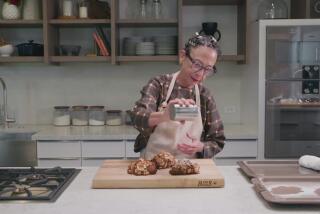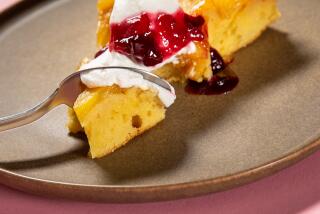Crowns of the counter: canneles
- Share via
It all started with a pan.
It was a dull orange silicone with little fluted hollows, sort of like a muffin tin. It might not have looked like much, but I knew what it could do: turn out canneles, the little French cakes I’d fallen for.
I snatched it off its rack in a Paris shop, with visions of freshly baked canneles in my own kitchen. Soon after I returned home, I found that the distinctively fluted pans, especially silicone ones, were showing up in stores and catalogs. Some could barely keep them in stock. It seemed my little find from Paris had been discovered.
And it’s no wonder. The Bordelaise cakes, shaped like golden crowns, are unlike any other pastry. Outside is a caramelized crunch, inside a silky softness. One bite gives you a sweet contrast of textures.
At first glance, canneles seem foolproof to make. The ingredients are simple: flour, sugar, milk, eggs, butter and, for flavor, vanilla and rum. No tricky technique is involved: Just mix, refrigerate, then bake.
It sounded easy enough, but a search for recipes turned up a befuddling range of ingredient proportions and baking times. And there is quite a range of pans too: small and large, silicone and metal, sheets of molds and individual cups.
I started with my silicone pan and one of the many recipes that I’d found online. The batter came together easily, but baking was another story. Canneles aren’t as forgiving in the oven as, say, muffins are. For one thing, uneven heat throws off their rising. And the baking must simultaneously produce two extremes: The cakes must be dark, shiny and crunchy outside, but pale and soft inside.
The first batch yielded several lopsided cakes instead of perfect little crowns. But at least they tasted right, with the requisite crust and soft interior.
More determined than ever, I added two more recipes to test and found other pans to try from baker friends who’d also discovered canneles. With the Times Test Kitchen’s help, the cannele making got interesting -- and frustrating.
We oiled silicone molds, as some recipes suggested. The canneles easily slid out, but they slumped to form grumpy faces.
We generously greased metal molds. But these turned out even grumpier, stubbornly sticking to the bottoms and sides.
Some tasted raw inside. Others were inedibly burned. Dozens of cakes later, I began to wonder if I could even remember what a good cannele tasted and looked like. I tried hard to think of that moment months ago, when my friend Laura and I swooned over a fantastic cannele from the famed Paris food shop Fauchon. The memory was getting fuzzy.
Good thing one of the recipes -- the first one I tried -- consistently turned out better and better cakes. But it took a lot of baking to learn these lessons:
* Resist the temptation to bake before the batter has sat for at least 24 hours.
* Thoroughly stir it before ladling or pouring into the molds.
* Rotate the pan at least once in the oven to ensure even rising (though the cakes will settle down slightly in the center as they cool).
That successful recipe, which had been posted on an obscure page of a cooking school’s Web site, was credited to American pastry chef Nick Malgieri, who has spent part of his career baking in fine establishments in France.
However, even he found the perfect cannele difficult to define. “It’s definitely not the inside of any bread, cake or pastry you’re familiar with,” he said. “The closest thing you can compare a cannele to is a Krispy Kreme doughnut in the sense that it has that inside that’s very creamy” in contrast to its glaze casing.
“They should be dark on the outside, slightly crisp; the inside is very soft, warm, sweet, aromatic.”
And though my memory was of golden crowns, Malgieri said that some places in France bake canneles till they’re pitch-black, albeit without a burned taste. He attributed that to the beeswax used to coat the molds before they are filled.
The recipe I tried, he said, was his adaptation of a French one given to him by one of his cooking school students. I later came across a similar one in a cookbook by French chef Michel Roux; he attributed it to a pastry chef near Bordeaux, home of the cannele. Like Malgieri’s adaptation, the recipe includes condensed milk. Still, Malgieri offered another recipe from a French cookbook by revered pastry chef Pierre Herme.
Our tasters mostly liked Herme’s recipe too, but we tipped in favor of Malgieri’s, because it comes together much more quickly. Herme’s recipe took eight more hours, the time for two vanilla pods to soak in milk before the batter is even made. And Malgieri’s adaptation, with more rum and our addition of a little vanilla extract, turns out a cannele with a more nuanced flavor.
It was no problem eating all these canneles; after all, they taste best the day they’re made. (But you don’t have to bake all the batter at once. That’s the beauty of it: It keeps for up to five days. You can have canneles fresh from the oven every day if you wanted.)
I’ve since learned from a friend that La Brea Bakery sells canneles. But the real fun is in the baking, then eating them warm. All you need is a pan.
*
Canneles
Total time: 1 hour, 15 minutes, plus 24 hours chilling
Servings: About 27
Note: From Nick Malgieri
2 1/4 cups sugar
1 2/3 cups unbleached, all-purpose flour
1 (14-ounce) can sweetened condensed milk
3 eggs
2 egg yolks
5 tablespoons dark rum
2 teaspoons vanilla extract
2 1/2 cups water
1/4 cup ( 1/2 stick) butter
1/2 cup nonfat dry milk
1. The day before you intend to bake the canneles, make the batter: Combine the sugar and flour in a large mixing bowl and whisk to mix evenly. Whisk in the condensed milk, eggs, yolks, rum and vanilla.
2. Combine the water, butter and dry milk in a saucepan. Bring to a boil over low heat, whisking occasionally. Whisk the hot mixture into the flour and egg mixture until thoroughly combined. Pass the batter through a fine-meshed strainer into a container; let cool slightly, then cover tightly and refrigerate a minimum of 24 hours, a maximum of 5 days.
3. When you are ready to bake the canneles, heat the oven to 400 degrees.
4. Remove the batter from the refrigerator and whisk to combine, 1 minute. Fill cannele molds 3/4 full. (If using silicone molds, do not grease; tins should be lightly coated with oil.)
5. Bake until the canneles are firm and very dark brown, about 1 hour, changing the position of the pans several times -- back to front and top to bottom during baking. Let sit 5 minutes, then invert onto a rack. Gently pull the sides of the silicone mold out to release the canneles onto a rack. Serve warm.
Each serving: 176 calories; 34 mg. sodium; 49 mg. cholesterol; 4 grams fat; 2 grams saturated fat; 31 grams carbohydrates; 3 grams protein; 0 fiber.


